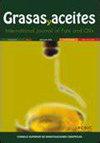评估樱桃月桂(Prunus laurocerasus L.)叶精油产量和成分的月度变化
IF 1
4区 农林科学
Q4 CHEMISTRY, APPLIED
引用次数: 0
摘要
本研究通过在土耳其连续 12 个月每月取样,对樱桃月桂叶挥发油含量和挥发性成分的月度变化进行了研究。收获期对挥发油含量有明显影响(P < 0.01)。根据收获期的不同,挥发油比率从 0.19% 到 0.35% 不等。八月、七月和九月的挥发油比率最高。经测定,挥发油中含有苯甲醛、苯酚、苯甲酸、苯乙腈、十五烷酮、1,54-二溴四十五烷和四十五烷。主要有效成分苯甲醛的比例介于 83.89% 和 94.41% 之间,具体取决于收获时间。樱花月桂叶应在七月、八月和九月采收,以获得较高的精油比率;应在五月、六月和七月采收,以获得较高的苯甲醛比率。由于其挥发油中含有高浓度的苯甲醛,樱桃月桂常绿树叶可被视为香料和制药行业的宝贵原料来源。本文章由计算机程序翻译,如有差异,请以英文原文为准。
Evaluation of monthly changes in essential oil yield and components of cherry laurel (Prunus laurocerasus L.) leaf
This research was carried out to examine the monthly changes in both the volatile oil content and volatile components of cherry laurel leaves by taking samples every month for 12 months in Turkey. Harvest periods significantly affected volatile oil content (P < 0.01). Depending on harvest periods, volatile oil ratios ranged from 0.19 to 0.35%. The months of August, July, and September yielded the highest volatile oil ratios. Benzaldehyde, phenol, benzoic acid, benzeneacetonitrile, pentadecanone, 1,54-dibromotetrapentacontane and, tetrapentacontane were determined as components in the volatile oil. The ratio of benzaldehyde, the main active ingredient, varied between 83.89 and 94.41%, depending on the harvest time. The cherry laurel leaf should be harvested in July, August, and September for high essential oil ratios and in May, June, and July for high benzaldehyde ratios. Due to the high concentration of benzaldehyde in its volatile oil, cherry laurel evergreen leaf can be considered a valuable source of raw materials for the fragrance and pharmaceutical sectors.
求助全文
通过发布文献求助,成功后即可免费获取论文全文。
去求助
来源期刊

Grasas y Aceites
工程技术-食品科技
CiteScore
2.50
自引率
0.00%
发文量
50
审稿时长
3 months
期刊介绍:
Grasas y Aceites is a peer-reviewed journal devoted to the publication of original articles concerning the broad field of lipids, especially edible fats and oils from different origins, including non acyl lipids from microbial origin relevant to the food industry. It publishes full research articles, research notes, reviews as well as information on references, patents, and books.
Grasas y Aceites publishes original articles on basic or practical research, as well as review articles on lipid related topics in food science and technology, biology, (bio)chemistry, medical science, nutrition, (bio)technology, processing and engineering. Topics at the interface of basic research and applications are encouraged. Manuscripts related to by-products from the oil industry and the handling and treatment of the wastewaters are also welcomed.
Topics of special interest to Grasas y Aceites are:
-Lipid analysis, including sensory analysis
-Oleochemistry, including lipase modified lipids
-Biochemistry and molecular biology of lipids, including genetically modified oil crops and micro-organisms
-Lipids in health and disease, including functional foods and clinical studies
-Technical aspects of oil extraction and refining
-Processing and storage of oleaginous fruit, especially olive pickling
-Agricultural practices in oil crops, when affecting oil yield or quality
 求助内容:
求助内容: 应助结果提醒方式:
应助结果提醒方式:


